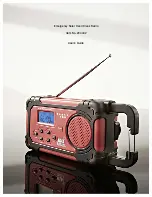
Lt.
Hand Crank Warning
To prevent overheating of the dynamo hand crank and permanent damage, do not crank faster than
approximately two revolutions per second. Do not crank continuously for more than two minutes.
After two minutes, allow two minutes of rest before cranking again.
3. Features
The Emergency Solar Hand Crank Radio includes the following features:
Super bright 3 LED flashlight
AM/FM with Weather Band Feature
Weather Alert Feature (public alert certified)
Emergency smart phone/mp3/mp4/USB charger
Backlight digital display
Clock
Audio output (headphones)
4. Power Sources
The Emergency Solar Hand Crank Radio can be powered from the following sources:
DC power from a USB power source, such as a computer
AC power by adding a USB to AC adaptor (not included)
DC car charger by adding a USB to DC car adaptor (not included)
Solar power
Hand crank power
Three AAA batteries (not included)
NOTE:
There is a charging LED on the back of the unit (Figure 2, reference 18). The LED is flashing
during charging. When fully charged, the LED will tum on constantly.
NOTE:
Lithium battery is always on priority in power supply compared with AAA batteries. Only
when lithium battery has insufficient power or there's no lithium battery at all will AAA battery power
be used.
4.1 DC and AC Power
Prior to using the Emergency Solar Hand Crank Radio, we recommend you fully charge the
rechargeable battery through the USB Power Input (Figure 2). This may take up to four hours.
Connect the DC power input cable to the USB mini jack, and the other end to the USB power source.
The red battery charge indicator light will be flashing when charging (Figure 2). Continue to charge
the Emergency Solar Hand Crank Radio for several hours or until the charging light turns on
constantly. The Emergency Solar Hand Crank Radio is now ready for use.
NOTE:
Use 5.0V USB power source (from a computer or appropriate AC or DC adaptor). Over
voltage may result in damaging the Emergency Solar Hand Crank Radio.
4.2 Solar Power
Place the Emergency Solar Hand Crank Radio in direct ( or indirect) sunlight with the solar panel
































